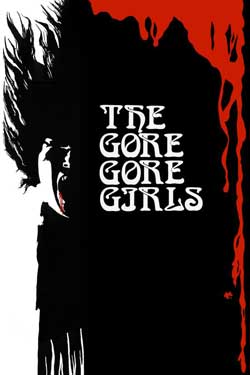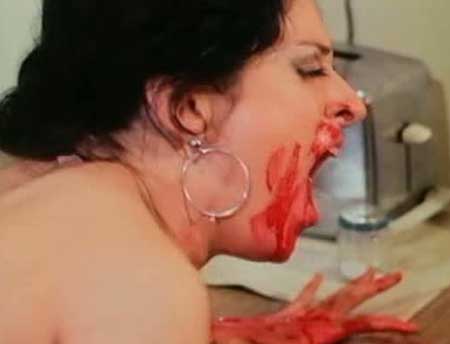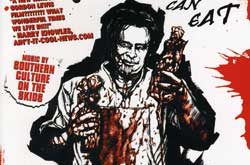SYNOPSIS:
A ditsy reporter enlists the help of a sleazy private eye to solve a series of gory killings of female strippers at a Chicago nightclub.
REVIEW:
Before I start this review, I feel that I need to provide what they call in the business as a “full disclosure.” Herschell Gordon Lewis is one of my filmland heroes, right up there with Russ Meyer and John Waters. I have met him and we had a nice conversation; he was very nice. On the wall in front of my computer, right next to my 8 x 10 of the cast of Welcome Back, Kotter, is a signed movie poster from The Wizard of Gore. In fact, my dvd copy of this very movie is also signed. The Gore Gore Girls is a movie that I first saw when I was in college. I was at a friend’s birthday party, and while they were mixing drinks and passing out, I found myself sitting in the living room, watching the second half of this movie. It was my first introduction to Mr. Lewis, and it has remained close to my heart ever since. And to think, for thirty years this was known as H. G. Lewis’ last movie.
Let’s rewind and start at the beginning. For those who aren’t familiar, Herschell Gordon Lewis is widely known as the “Godfather of Gore” thanks to his efforts in the exploitation market in the 1960’s and early 1970’s (in that time, making a name for himself in the underground and drive-in cinema world with films such as Blood Feast and Two Thousand Maniacs!). In 1972, he decided that the exploitation market was fading and so fell back to a career in marketing (in which he was very successful as well) until the 2002 release of Blood Feast 2: All U Can Eat. Luckily, before heading into greener fields, Lewis graced us with the release of The Gore Gore Girls (sometimes known as Blood Orgy), a somewhat controversial and, at the time, X-rated film about a series of brutal killings of exotic dancers.
The movie opens with a girl fixing her hair in the mirror. A shadowy figure quickly appears behind her and smashes her face into the mirror, not once, but over and over, then begins stabbing her. By the time the killing is completed, the girl (who we later learn is named Suzie Cream Puff) is unrecognizable. This is all within the first fifty seconds. No backstory, no set-up, no establishing shots, we just jump head first into the gore. Credits roll, jazzy intro theme plays, and away we go!
The entire eighty minute running time pretty much sets up a looping pattern and follows it to the end. We meet Abraham Gentry (played by Frank Kress), a private investigator who is promised a large sum of money to take on the case of the murdered dancer. He is offered the money by Nancy Weston (Amy Farrell, who also had a small role in Airport 1975), a reporter from the local newspaper. Gentry is c**ky, but Weston manages to stick to his side throughout, whether he likes it or not. Gentry goes to a strip club to question a dancer, we see a couple minutes of a striptease, a red herring is thrown out, and by the time Gentry and Weston can get anywhere, there is another awkwardly named dancer (Candy Cane, Pickles, etc…) murdered in brutal (and darkly comedic) fashion. A typical slasher film, to be honest, but we’re not here for the plot. This is a Herschell Gordon Lewis film after all.
The characters are especially fun in this one. Abraham Gentry is hilarious in his crudeness, carrying a cane and using it, rather than his hands, to interact the various people he comes into contact with whom he feels are beneath him. Nancy Weston is the reporter who gets the ball rolling, but we later know her more as a lightweight drunk who is attracted to Gentry. We have the various dancers/victims who seem to only be good at screaming and being splattered across the set. There is Barney the bartender, played by Ray Sager (a H. G. Lewis regular, probably more recognizable in the role of Montag the Magnificent in The Wizard of Gore). There’s Marlene (played by Hedda Lubin), the agitated waitress who seems to work at every club in town. Grout, the Vietnam veteran who spends his time as bouncer drawing faces on fruit and smashing it. Mary McHenry, the leader of a Feminist Rights group who protests the strip clubs and seems too obvious to be the killer (or does she?). And we can’t forget the owner of ALL of the strip clubs where the murdered dancers work, Marzdone Mobilie, played by comedian Henny Youngman (a role he allegedly later denied ever playing).
As usual, the colorful characters of Lewis’ film are second only to the brutal gory murders throughout. If you’ve seen a H. G. Lewis movie before, you know that the special effects are over the top and always with a hint of dark humor, and The Gore Gore Girls follows this trend and even kicks it up a notch. Amongst the split open heads, bright red blood, and squished eyeballs, we also get some chuckles along with our up-chuck. A woman is killed by having her rump roast pulverized by a meat tenderizer, some spices generously applied after her last breath. When another victim’s nipples are cut off, one breast shoots regular milk into a glass while the other releases chocolate milk.
The entire movie plays like a game of Clue, as the killer’s identity is not revealed until the very end and we are instead presented with a host of possible suspects/red herrings to choose from. Of course I’m not going to reveal how the movie ends, but I will recommend that the first time viewer keep an open mind when considering possibilities.
The Gore Gore Girls features decent-at-best acting, some uncomfortable edits (sometimes background music is only heard when one specific angle is shown), and a plot that repeats itself over and over until it seems an ending might be necessary. At the same time, it features hilarious gory scenes right from the start, with ridiculousness and schlock around every corner. I don’t just recommend this movie to a hardcore horror fan, I recommend the entire Herschell Gordon Lewis catalog.
The Gore Gore Girls (1972)
 Horror News | HNN Official Site | Horror Movies,Trailers, Reviews
Horror News | HNN Official Site | Horror Movies,Trailers, Reviews











